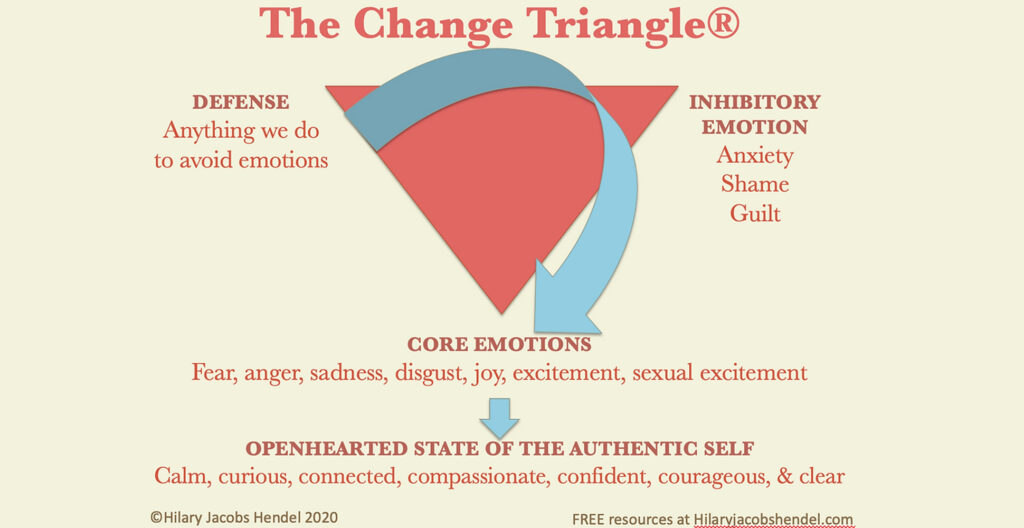Accelerated Experiential Dynamic Psychotherapy (AEDP) is an evidence-based therapy that puts neuroplasticity into action. It was developed by Dr. Diana Fosha in the year 2000 with her publication “The Transforming Power of Affect.” AEDP believes that you have the power to rewire your brain and provide yourself with corrective healing experiences. By increasing our awareness of emotions, defenses, and impulses, we gain the power to choose how we want to respond when emotions arise instead of remaining stuck in automatic responses. Once we allow ourselves to fully experience core emotions, we can unlock our authentic selves: the selves that are calm, compassionate, curious, creative, clear-minded, confident, and courageous.AEDP uses what they call the “Change Triangle” as a framework to illustrate the ways we disconnect from our core emotions. Defenses are on one side, inhibitory emotions on the other, and core emotions are at the bottom. Defenses are anything we do in order not to feel. Inhibitory emotions–such as guilt, anxiety, and shame–block us from feeling our core emotions. Core emotions are on the bottom: fear, anger, sadness, joy, excitement, sexual excitement, and disgust. Emotions just are. They are not inherently good or bad; they are adaptive responses that inform us of our needs. For example, your anger may be telling you that a boundary of yours has been violated. The goal is to look beyond our defenses and inhibitory emotions and discover our core emotions. By noticing and processing these emotions, we can then move to the open-hearted state. This is much easier said than done.

At some point along the way, you may have learned to disconnect from your body’s experience of emotions. We learn which emotions are acceptable and which ones are not acceptable based on how expressions of them were responded to. Inhibitory emotions, such as guilt, shame, and anxiety, develop because we are social creatures. We adapt to remain lovable, especially as young children who need attention and care from our caretakers. For example, if when you were sad as a child, you were taught to “suck it up” or told that “crying means you’re weak”, you might learn to not let yourself feel sad. Maybe you adapted by instead becoming anxious whenever you might feel sad. Anxiety inhibits the feeling of sadness. Perhaps when you feel the heaviness in your chest and your throat begins to tighten, your body automatically becomes rigid and your heart starts beating faster. Maybe you reach for your phone to scroll as a distraction. Anything to avoid sitting in the discomfort of a certain emotion.

Instead of approaching our defenses and inhibitory emotions with the intention to blame, we approach them with curiosity and gratitude. Maybe your perfectionism saved you from being ridiculed for mistakes as a child. Maybe you became passive in order to not create more chaos in your household. Being assertive could’ve been dangerous. This could also be true for emotions like joy and excitement. Maybe you were often told to keep your voice down or to sit still and now wonder why feelings of shame accompany feelings of excitement.
Perhaps now these defenses no longer serve you. What would it be like to thank them for their help and ask them to step aside? It might be scary to think about. Maybe you’re afraid that if you let yourself feel all the sadness, you’ll never stop crying. Our instinct is to avoid thinking about emotions that we are uncomfortable with, fearing that if we acknowledge them they will grow even bigger and out of our control. In reality, the opposite is true. Once we look our emotions in the face, honor them by giving them the space they need to fully feel, their grip on us loosens.
Each individual has unique sensations that accompany their emotions; the trick is tuning into these sensations when we notice emotions arise. By learning what our bodily sensations tell us when we feel an emotion, we can re-integrate our feelings with our thoughts, our bodies with our minds. We are integrating dissociated neural networks which calms down the nervous system, allowing us to stay in our open-hearted state. It is a huge relief to discover and honor the true emotion behind our defenses and inhibitory emotions. By moving through the change triangle and allowing ourselves to fully experience our emotions, we can move past traumatic experiences, learn what parts of us need to heal, and spend more time with our true authentic selves.
Please visit goodtherapysandiego or contact us at (619) 330-9500 to get started with a therapist today!








